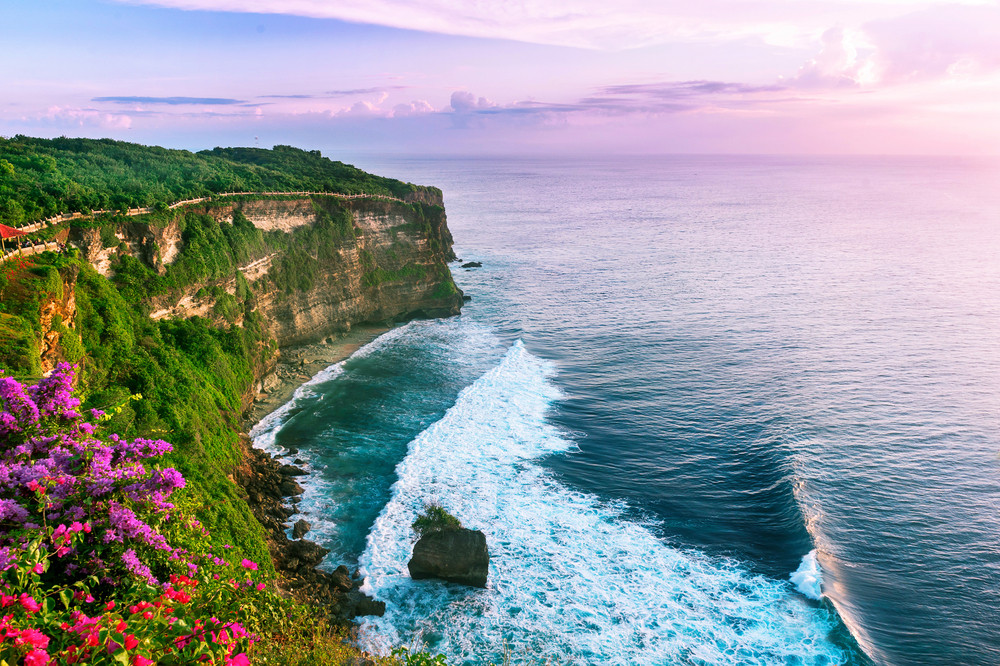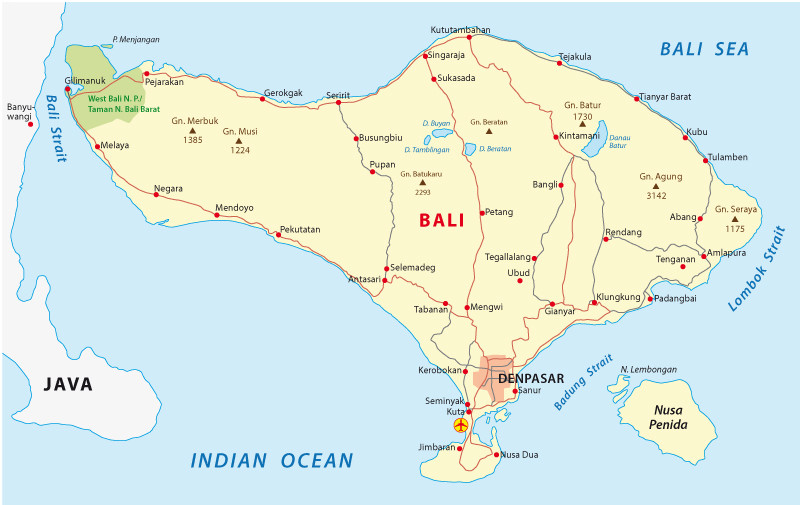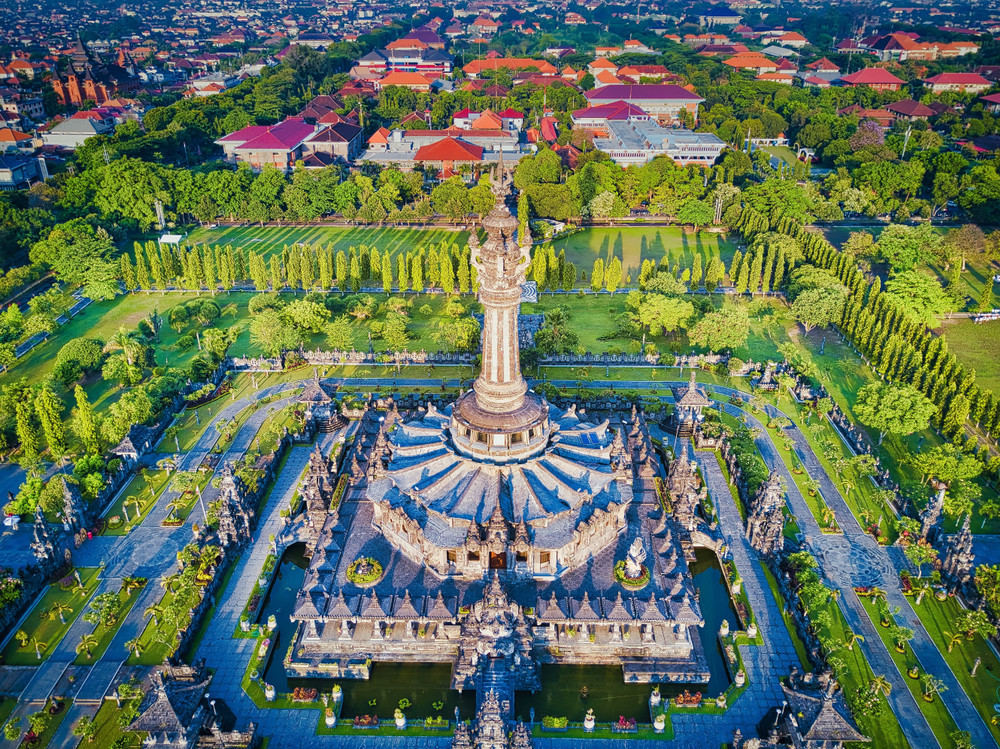Bali, the famed “Island of Gods,” conjures images of serene beaches, lush rice paddies, and vibrant culture. But before you pack your bags for this Indonesian paradise, a fundamental question arises: Bali Where Is It? Understanding Bali’s location is key to appreciating its unique climate, culture, and geographical context within the vast Indonesian archipelago.
 Beautiful Uluwatu Cliff in Bali
Beautiful Uluwatu Cliff in Bali
Bali is nestled within Indonesia, a sprawling nation comprised of over 17,500 islands extending across a massive area in Southeast Asia and Oceania. Indonesia itself is strategically positioned in the Southern Hemisphere, bridging Asia and Australia. To pinpoint Bali more precisely, it’s situated in the westernmost part of the Lesser Sunda Islands, flanked by Java to the west and Lombok to the east. This places Bali approximately 8 degrees south of the equator, a crucial factor in determining its tropical climate.
Geographically Pinpointing Bali: A Closer Look
To truly understand “bali where is it”, we need to delve into its geographical coordinates and surrounding features. Bali is an island province of Indonesia, a transcontinental country with a significant portion in Southeast Asia and parts extending into Oceania.
Bali’s Location within Indonesia and Southeast Asia
Indonesia’s location in Southeast Asia is significant. It shares land borders with Malaysia, Papua New Guinea, and Timor-Leste, further anchoring Bali within this dynamic region. Being part of Indonesia places Bali within the world’s largest archipelago, a nation known for its incredible biodiversity and cultural richness.
Positioned Between Java and Lombok
Bali’s immediate neighbors are the islands of Java and Lombok. Java, located just west across the Bali Strait, is home to Indonesia’s capital, Jakarta. To the east, across the Lombok Strait, lies Lombok, another popular Indonesian island, and the Gili Islands. This strategic positioning between major islands contributes to Bali’s role as a central hub within the Indonesian archipelago.
 Bali on the map
Bali on the map
The Bali Sea and the Flores Sea
When considering “bali where is it” in terms of oceans, Bali is bordered by the Bali Sea to the north, which then merges into the larger Flores Sea. The Bali Sea, specifically the southwest portion of the Flores Sea, covers an area of approximately 45,000 square kilometers. These warm waters are not only teeming with marine life but also contribute to Bali’s famed surfing conditions, particularly on the western coasts.
Bali and the Pacific Ring of Fire
Indonesia’s location on the Pacific Ring of Fire has profound implications for Bali. This Ring of Fire is a major area in the Pacific Ocean basin known for intense seismic and volcanic activity. It hosts a staggering 75% of the world’s active and dormant volcanoes, and Indonesia is home to a significant number of these. While this geological activity shapes the landscape and enriches the soil, it also means Bali experiences earthquakes and potential volcanic events.
Bali’s Country and Capital: Political Geography
Beyond the physical geography, understanding “bali where is it” also involves its political affiliation and administrative center.
Bali is Part of Indonesia
To reiterate, Bali is an integral part of Indonesia. This is crucial for travel planning, visa requirements, and understanding the cultural and political context of the island. Indonesia’s vast archipelago status means Bali is one of over 17,500 islands, yet it stands out as the most globally recognized and visited. Despite the vast number of islands in Indonesia, only a fraction, around 922, are inhabited, highlighting Bali’s significance and development.
Denpasar: Bali’s Capital City
Denpasar serves as the capital city of Bali. Located on the southern part of the island, Denpasar is the primary entry point for most visitors as it houses Bali’s main international airport, Ngurah Rai International Airport (DPS). As the capital, Denpasar is a bustling urban center offering a blend of Balinese culture and modern amenities. Popular attractions within Denpasar include the Jagatnatha Temple, the Bajra Sandhi Monument, and the Turtle Conservation and Education Center, making it more than just a transit point.
 Aerial view of Bajra Sandhi Monument in Denpasar
Aerial view of Bajra Sandhi Monument in Denpasar
In 2010, Denpasar’s population was recorded at 788,445, while the entire island of Bali was home to approximately 4,225,000 people by 2014. These figures underscore Denpasar’s role as a significant urban center and Bali’s overall substantial population.
Bali’s Wider Geographical Context
Understanding “bali where is it” also means considering Indonesia’s broader geographical relationships. While Bali itself has maritime borders, Indonesia as a nation shares land borders with several countries and maritime borders with many more.
Neighboring Islands: Java and Lombok
As mentioned, Java and Lombok are Bali’s closest island neighbors. This proximity influences cultural exchange, trade, and travel patterns within the region.
Indonesia’s Broader Borders
Indonesia’s land borders are shared with Malaysia on the island of Borneo, Papua New Guinea on the island of New Guinea, and Timor-Leste on the island of Timor. Maritime borders extend even further, including India, Singapore, Vietnam, the Philippines, Palau, and Australia. This expansive network of borders highlights Indonesia’s, and consequently Bali’s, strategic and interconnected location within the broader Asian and Oceanian regions.
Conclusion: Bali’s Location Defined
So, to definitively answer “bali where is it?”, Bali is an island province of Indonesia, situated in Southeast Asia, between the islands of Java and Lombok. It lies in the Bali Sea, part of the Flores Sea, and is positioned about 8 degrees south of the equator. Understanding Bali’s location not only clarifies its geographical coordinates but also provides context for its climate, culture, and place within the Indonesian archipelago and the world. This knowledge enriches the appreciation of Bali as a unique and captivating destination.
